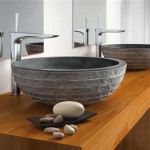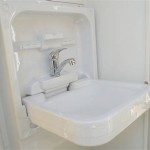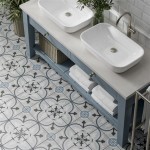What Color To Paint a Black and White Bathroom Vanity
A bathroom vanity serves as a focal point in the room, offering storage and contributing significantly to the overall aesthetic. When working with a pre-existing black and white bathroom, the vanity's color choice becomes a critical decision. The color should complement the existing monochromatic scheme, enhance the desired mood, and account for factors like lighting and room size. This article will explore various color options for a black and white bathroom vanity, providing insight into their specific effects and suitability within different bathroom designs.
Black and white bathrooms offer a classic and versatile canvas. The inherent contrast allows for a wide array of potential vanity colors, ranging from subtle neutrals to bold, saturated hues. However, the best color will depend on the specific design goals and the overall environment. Before selecting a color, it's necessary to consider the existing proportions of black and white, the amount of natural and artificial light, and the desired atmosphere of the room.
Understanding the Impact of Neutral Colors
Neutral colors offer a safe and sophisticated approach to painting a bathroom vanity in a black and white space. These colors, including grays, beiges, and off-whites, blend seamlessly with the existing color scheme, creating a cohesive and calming environment. The specific shade of neutral can be tailored to either soften the contrast or subtly enhance it.
Gray is a frequently chosen neutral for black and white bathrooms. A light gray vanity softens the stark contrast between the black and white elements, producing a more relaxed and modern feel. A darker gray, such as charcoal, can add depth and sophistication, echoing the black accents and creating a more dramatic effect. The specific gray tone should be chosen in conjunction with the other hardware and fixtures in the bathroom to maintain consistency and visual harmony. For example, if the hardware is chrome, a cooler gray might provide a more cohesive aesthetic. If the hardware is brushed nickel or bronze, a warmer gray could be a better selection.
Beige, and its variations like cream and ivory, introduces warmth to a black and white bathroom. This is especially useful if the room tends to feel cold or sterile. Beige vanities can soften the high contrast and provide a more inviting atmosphere. The specific shade of beige should be chosen carefully to avoid clashing with the existing white tones. A beige with yellow undertones could appear dingy against bright white tiles, while a beige with pink undertones might not complement the black accents effectively. Off-white colors, such as eggshell or antique white, offer a similar effect but may be a preferable choice if a lighter, brighter look is desired.
White itself is a possibility, especially if the existing white in the bathroom is a specific shade and the vanity color can precisely match. This creates a seamless, minimalist aesthetic. However, if the vanity's white is slightly different, it can draw unwanted attention and appear mismatched. It is crucial to carefully consider the existing white tones if considering this option.
Exploring the Potential of Accent Colors
Accent colors provide an opportunity to inject personality and vibrancy into a black and white bathroom. These colors can range from muted pastels to bold primary hues, creating a focal point and enriching the overall visual experience. The choice of accent color should be carefully considered, taking into account the desired mood and the existing elements in the room.
Blue is a popular choice for bathrooms due to its association with water and tranquility. A light, airy blue can create a serene and spa-like atmosphere in a black and white bathroom. A darker, more saturated blue, such as navy or royal blue, can add a touch of drama and sophistication. The specific shade of blue should be selected to complement the existing white tones and the overall style of the bathroom. For example, a coastal-themed bathroom might benefit from a light, seafoam blue, while a more traditional bathroom might suit a deeper, richer navy.
Green offers a refreshing and natural feel, bringing a touch of the outdoors into the bathroom. A soft, muted green can create a calming and relaxing atmosphere, while a bolder, more vibrant green can add a pop of energy and visual interest. The specific shade of green should be chosen to complement the existing black and white elements and the overall design scheme. For example, a modern bathroom might benefit from a bright, lime green, while a more rustic bathroom might be better suited to a deep, forest green.
Yellow is a cheerful and uplifting color that can brighten up a black and white bathroom. A soft, pastel yellow can create a warm and inviting atmosphere, while a brighter, more saturated yellow can add a playful and energetic touch. The specific shade of yellow should be chosen carefully to avoid clashing with the existing white tones and overwhelming the space. For example, a small bathroom might benefit from a light, buttery yellow, while a larger bathroom could handle a bolder, more vibrant lemon yellow.
Other accent color options include red, orange, and purple. Red can add a dramatic and passionate touch but should be used sparingly to avoid overwhelming the space. Orange offers a warm and energetic feel, suitable for creating a vibrant and playful atmosphere. Purple can add a touch of luxury and sophistication, but the specific shade should be chosen carefully to avoid appearing too feminine or overwhelming.
Considering Bold and Dramatic Choices
For those seeking a more unconventional and eye-catching design, bold and dramatic color choices for the vanity can transform a black and white bathroom into a statement space. These colors can add depth, personality, and a unique touch, but they require careful consideration and execution to avoid overwhelming the room.
Black can create a striking and sophisticated effect. A black vanity in a black and white bathroom amplifies the dramatic contrast and adds a touch of modern elegance. To prevent the black vanity from appearing too heavy or overwhelming, it is essential to balance it with lighter elements and ample lighting. This could include light-colored countertops, bright white walls, and strategically placed light fixtures. The finish of the black paint should also be considered, with matte finishes offering a softer look and gloss finishes providing a more reflective and impactful statement.
Another option is a metallic finish, such as gold, silver, or bronze. A metallic vanity can add a touch of glamour and luxury to a black and white bathroom. Gold can create a warm and opulent feel, while silver offers a more modern and sleek aesthetic. Bronze can add a touch of rustic elegance. The specific metallic finish should be chosen to complement the existing hardware and fixtures in the bathroom. It is crucial to avoid using multiple metallic finishes, as this can create a cluttered and inconsistent look.
A bold, saturated color, such as a deep teal or emerald green, can create a striking focal point in a black and white bathroom. These colors add depth and personality, transforming the space into a more unique and engaging environment. However, it is essential to use these colors sparingly and to balance them with lighter elements to prevent overwhelming the room. The specific color should be chosen carefully to complement the existing black and white elements and the overall style of the bathroom. For example, a mid-century modern bathroom might benefit from a deep teal, while a more traditional bathroom might suit an emerald green.
Ultimately, the best color to paint a black and white bathroom vanity depends on the desired aesthetic, the size of the room, the amount of natural light, and the existing elements in the space. Careful consideration of these factors will ensure a cohesive and visually appealing result that enhances the overall bathroom design.
The paint finish is also an important factor. For bathrooms, a semi-gloss or gloss finish is generally recommended. These finishes are durable, moisture-resistant, and easy to clean, making them ideal for a high-humidity environment. Matte finishes, while aesthetically pleasing, are more porous and can be more difficult to clean and maintain in a bathroom setting. The quality of paint used is also important, opting for a high-quality paint will ensure a long-lasting and durable finish.
Finally, consider testing paint samples before making a final decision. Paint colors can appear different in different lighting conditions, so it is crucial to test the colors in the actual bathroom environment. Paint samples can be purchased from most paint stores, and it is recommended to paint a small area on the vanity or a piece of cardboard to see how the color looks in the space before committing to painting the entire vanity.

Black And White Bathrooms Design Ideas Decor Accessories

15 Black And White Bathroom Ideas Tile Designs We Love

51 Gorgeous Black Vanity Ideas For A Stylishly Unique Bathroom

Why A Classic Black And White Bathroom Is Always Winner Decoholic

Bathroom Vanity Makeover With Chalk Paint Decor Adventures

14 Bathroom Paint Colors Ideas And Inspiration Benjamin Moore

What Color Should You Paint A Black And White Tiled Bathroom

Black And White Bathroom Mini Makeover Complete Brooklyn Limestone

14 Bathroom Paint Colors Ideas And Inspiration Benjamin Moore

15 Black And White Bathroom Ideas Tile Designs We Love
Related Posts







